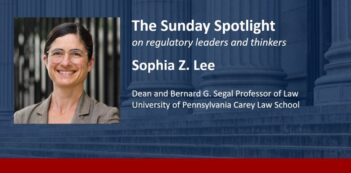
Congress must not forget its role in setting regulatory policy.
In his recent essay, “The Regulatory Blame Game,” Cary Coglianese focused on congressional responses to disasters attempting to pin blame on regulators when it often lies elsewhere – on the inevitable fruition of risk whose incidence can only be reduced but not eliminated; on the kinds of trade-offs cost-benefit analyses encourage by accepting a level of regulation beyond which costs will acceptably be incurred; and on the misbehavior of businesses ultimately at fault for deliberate corner-cutting, reliance on low enforcement, or simple negligence. Congress could fix some problems, he wrote, by passing new legislation adding new authority or reorganizing public agencies.
What he noted only glancingly is the relationship between agency “failures” and Congress’ budgetary choices. Here is all he said about that: “It also is hardly realistic to tighten agencies’ budgets while expecting they will have the resources to find and address all risks of harm from the hundreds of thousands of businesses they oversee.” That element, in my judgment, deserved more direct statement, even pride of place. Understandably, perhaps, members never point their fingers at themselves for the results of their decisions on agency funding. And the impact of those decisions is palpable.
This is not a new phenomenon. Years ago, before we lost the illusion that our government’s fiscal resources for regulation were essentially bottomless, the great administrative law scholar Louis Jaffe wrote poignantly in what appears to have been his last published work about “The Illusion of the Ideal Administration.” The Federal Communications Commission, he argued, should not be measured against some ideal of its possible accomplishments, but against how well it had used the resources Congress had given it in doing the jobs Congress had assigned it. And we no longer hold that illusion. As I write, we seem possibly just to have avoided going over the fiscal cliff that would reduce even further the limited “discretionary spending” resources agencies are afforded in a time of fiscal stringency to do the work Congress has assigned to them.
The recent death of the American ambassador to Libya brought the problem to the front pages. At least one element of the failures that led to his demise was that Congress had refused requested supplemental appropriations for increasing diplomatic security. How quickly Congress obscured this truth with secondary disputes over who said what and to whom knowing how much, after this event.
Under that radar, budgetary constraints constantly impinge on agency possibilities. Anyone wishing clear confirmation of that need only consult the Occupational Safety and Health Administration’s (OSHA) annual (and exemplary) website explanation of how it will be ordering its site-specific enforcement priorities in the coming year. OSHA defines two rates associated with workplace injuries at sites other than construction sites – DART (Days Away, Restricted or Transferred) and DAFWII, Days Away From Work Injury and Illness. Both are normalized to workforce size at any given plant, and calculated on the basis of required employer reports. The national DART rate for private industry for 2009 was 1.8, and the DAFWII case rate was 1.1. For 2011-12, the only manufacturing establishments OSHA required to be inspected were those presenting emergency situations (for example, worker death) and those with a DART rate of 7.0 or a DAFWII rate of 5.0 – in each case roughly four times the national average. For non-manufacturing establishments and Nursing and Personal Care Facilities, the contrast is more than twice as severe. If resources permit, inspections may then be made of facilities roughly three times the national average.
How OSHA allocates its budget is the product of judicial oversight as well. Years ago, OSHA developed an exemplary, award-winning ordering program offering strong incentives to Maine’s 200 most hazardous industrial sites in the state to engage in cooperative efforts to reduce injuries, a program that not only reduced injuries dramatically but also saved agency resources. When OSHA sought to make the program national, the D.C. Circuit struck it down. And then there are the agency costs frequently ascribed to the judiciary’s “ossification” of rulemaking by stringent review practices, reducing the extent to which agencies can adopt new regulations.
One result not only of judicial ossification but also of congressional preferences (expressed, for example, in the National Technology Transfer Advancement Act) has been increasing agency use of “voluntary consensus standards” developed by private bodies such as the American Society of Mechanical Engineers or the American National Standards Institute (ANSI). At its founding, OSHA was required to adopt consensus standards developed by ANSI, as a starting point; when it later tried to update those standards by a single rulemaking that incorporated all of ANSI’s changes in what it had previously adopted, the Eleventh Circuit reasoned from a few deficiencies that the effort was lacking – if OSHA must proceed industry by industry, ossification costs again. ANSI and OSHA have continued the effort. Can one be as assured as may be possible for ANSI and OSHA, when the Pipeline and Hazardous Materials Safety Adminisration, a demonstrably weak and underfunded agency, turns the development of public pipeline safety hazard warnings over to the American Petroleum Institute or surrenders the formulation of pipeline corrosion standards to the Pipeline Research Council International, “a community of the world’s leading pipeline companies”? Note that agencies’ diminishing resources diminish any capacity for oversight of these private activities, too.
So perhaps the right advice to Congress, unavailing as it might be yet helpful to our own understanding how “blame” might be assessed, is
why beholdest thou the mote that is in thy brother’s eye, but considerest not the beam that is in thine own eye? Or how wilt thou say to thy brother, Let me pull out the mote out of thine eye; and, behold, a beam is in thine own eye? Thou hypocrite, first cast out the beam out of thine own eye; and then shalt thou see clearly to cast out the mote out of thy brother’s eye. — Matthew 7:1-5




